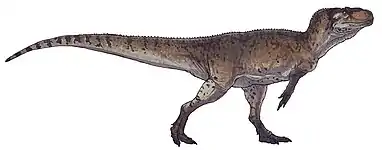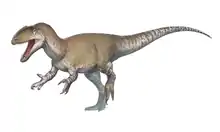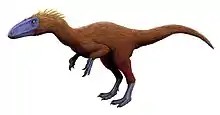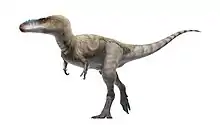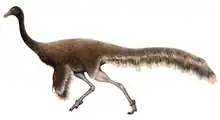| Calamosaurus Temporal range: Barremian, | |
|---|---|
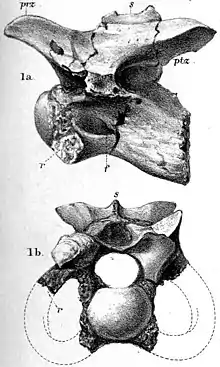 | |
| Cervical vertebra of Calamosaurus foxi | |
| Scientific classification | |
| Domain: | Eukaryota |
| Kingdom: | Animalia |
| Phylum: | Chordata |
| Clade: | Dinosauria |
| Clade: | Saurischia |
| Clade: | Theropoda |
| Family: | †Compsognathidae |
| Genus: | †Calamosaurus Lydekker, 1891 |
| Species: | †C. foxi |
| Binomial name | |
| †Calamosaurus foxi (Lydekker, 1889 [originally Calamospondylus]) | |
| Synonyms | |
| |
Calamosaurus (meaning "reed lizard") was a genus of small theropod dinosaur from the Barremian-age Lower Cretaceous Wessex Formation of the Isle of Wight, England. It is based on two cervical vertebrae (BMNH R901), collected by Reverend William Fox.
History and taxonomy
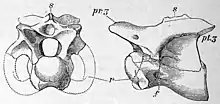
Richard Lydekker came across these bones when cataloguing the Fox collection and named them Calamospondylus foxi, noting their similarity to those of Coelurus.[1] Unfortunately, Calamospondylus had already been coined in 1866 (ironically by Reverend Fox himself, the very man honored in Lydekker's species name).[2] Lydekker renamed it in 1891 to its present title.[3] He also at this time provisionally referred to it the right tibia NHMUK R.186, which was discovered by William D. Fox in 1865 or 1866 and was identified by Naish et al. (2001) as belonging to a basal coelurosaurian like a compsognathid, and has recently been referred to Ornithomimosauria by Allain et al. (2014).[4][5] NHMUK R.186 has since been moved to Calamospondylus.
Because of its sparse remains, it has received little attention. Often, it has been synonymized with Calamospondylus as part of a long, confusing taxonomic tangle,[6][7][8] although there is no comparable material between the two genera.[4] Modern reviews have regarded it as a dubious theropod,[9][10] although potentially a valid coelurosaurian.[4]
In 2002 Paul Turner found a dorsal vertebra near Grange Chine on the Isle of Wight. An associated partial tibia and metatarsal fragment were subsequently discovered by Oliver Mattsson and referred to Calamosaurus.[11] Another specimen referred to Calamosaurus was collected by local fossil hunter Kai Bailey in 2014. Both specimens are on display at the Dinosaur Expeditions, Conservation and Palaeoart Centre near Brighstone, Isle of Wight.
A neck vertebra of a Calamosaurus was found near Chilton Chine on the Isle of Wight by local fossil hunter Dave Badman. The newly discovered vertebra has gone on display at the Dinosaur Isle Museum in Sandown, Isle of Wight.
Specimen NHMUK R.186
NHMUK R.186 was discovered by William D. Fox in 1865 or 1866 and was first assigned to Hypsilophodon foxii by Lydekker (1888).[12] Lydekker (1891) moved NHMUK R.186 to Aristosuchus pusillis,[13] and Galton (1973) agreed with this classification.[14] Welles & Long (1974) referred it to the Ornithomimidae,[15] while Norman (1990), Kirkland et al. (1998) and Long and Molnar (1998) referred NHMUK R.186 to Coelurosauria.[16][17][18] Galton and Molnar (2005) noted the similarities of NHMUK R.186 to the holotype of Coelurus fragilis,[19] and Allain et al. (2014) agreed with the palcement of NHMUK R.186 within Coelurosauria.[20]
Naish et al. (2001) tentatively referred the tibia to Calamosaurus foxi,[21] and NHMUK R.186 has since been moved to Calamospondylus oweni.[22]
Paleobiology
As a possible basal coelurosaur, Calamosaurus would have been a small, agile, bipedal carnivore. Naish et al. (2001) estimate the living animal would have been around 3–5 meters (9.8–16.4 ft) long, with a small head given the build of the neck vertebrae.[4]
References
- ↑ Lydekker. R. (1889). On a coelurid dinosaur from the Wealden. Geological Magazine 6:119-121.
- ↑ Fox, W.D. in Anonymous. (1866) Another Wealden reptile. Athenaeum 2014:740.
- ↑ Lydekker. R. (1891). On certain ornithosaurian and dinosaurian remains. Quarterly Journal of the Geological Society of London 47:41-44.
- 1 2 3 4 Naish, D., Hutt, S., and Martill, D.M. (2001). Saurischian dinosaurs 2: theropods. In: Martill, D.M., and Naish, D. (eds.). Dinosaurs of the Isle of Wight. The Palaeontological Association:London, 242-309. ISBN 0-901702-72-2
- ↑ R. Allain, R. Vullo, J. Le loeuff & J.-F. Tournepiche (2014) European ornithomimosaurs (Dinosauria, Theropoda): an undetected record. Geologica Acta 12: (2) (advance online publication) June 2014.
- ↑ Swinton, W.E. (1936). The dinosaurs of the Isle of Wight. Proceedings of the Geologists' Association 47(3):204-220.
- ↑ Romer, A.S. (1956). Osteology of the Reptiles. University of Chicago Press:Chicago, 1-772. ISBN 0-89464-985-X
- ↑ Steel, R. (1970). Part 14. Saurischia. Handbuch der Paläoherpetologie/Encyclopedia of Paleoherpetology. Part 14. Gustav Fischer Verlag:Stuttgart, 1-87.
- ↑ Norman, D.B. (1990). Problematic theropoda: "coelurosaurs". In: Weishampel, D.B., Dodson, P., and Osmólska, H. (eds.). The Dinosauria. University of California Press:Berkeley, 280-305. ISBN 0-520-06727-4.
- ↑ Holtz Jr., T.R., Molnar, R.E., and Currie, P.J. (2004). Basal Tetanurae. In: Weishampel, D.B., Dodson, P., and Osmólska, H. (eds.). The Dinosauria (second edition). University of California Press:Berkeley, 71-110. ISBN 0-520-24209-2.
- ↑ Naish, D. 2011. Theropod dinosaurs. In Batten, D. J. (ed.) English Wealden Fossils. The Palaeontological Association (London), pp. 526–559.
- ↑ Lydekker, Richard (1888). Catalogue of the fossil Reptilia and Amphibia in the British Museum (Natural history) ... By Richard Lydekker ... London: Printed by order of the Trustees.
- ↑ Lydekker, R. (1891). "On certain Ornithosaurian and Dinosaurian Remains". Quarterly Journal of the Geological Society. 47 (1–4): 41–44. doi:10.1144/gsl.jgs.1891.047.01-04.06. ISSN 0370-291X.
- ↑ Galton, P.M., (1973). A femur of a small theropod dinosaur from the Lower Cretaceous of England. Journal of Paleontology, 47, 996-997.
- ↑ Welles, S.P., Long, R.A., (1974). The tarsus of theropod dinosaurs. Annals of the South African Museum, 64, 191-218.
- ↑ Norman, D.B., (1990). Problematic Theropoda: “Coelurosaurs”. In: Weishampel, D.B., Dodson, P., Osmolska, H. (eds.). The Dinosauria. Berkeley, University of California Press, 280-305.
- ↑ Kirkland, J.I.; Britt, B.B.; Whittle, C.H.; Madsen, S.K.; Burge, D.L. (1998). "A small coelurosaurian theropod from the Yellow Cat Member of the Cedar Mountain Formation (Lower Cretaceous, Barremian) of eastern Utah". New Mexico Museum of Natural History and Science Bulletin. 14: 239–248.
- ↑ Long, J.A. and Molnar, R.E. (1998). "A new Jurassic theropod dinosaur from Western Australia". Records of the Western Australian Museum 19 (1): 221-229
- ↑ Galton, P.M., Molnar, R.E., (2005). Tibiae of small theropod dinosaurs from Southern England: from the Middle Jurassic of Stonesfield near Oxford and the Lower Cretaceous of the Isle of Wight. In: Carpenter, K. (ed.). The carnivorous dinosaurs. Bloomington and Indianapolis, Indiana University Press, 3-22
- ↑ Allain, R.; Vullo, R.; Le Louff, J.; Tournepiche, J-F. (2014). "European ornithomimosaurs (Dinosauria, Theropoda): an undetected record". Geologica Acta (17). doi:10.1344/105.000002083. ISSN 1695-6133.
- ↑ Naish, D., Hutt, S., and Martill, D.M. (2001). Saurischian dinosaurs 2: theropods. In: Martill, D.M., and Naish, D. (eds.). Dinosaurs of the Isle of Wight. The Palaeontological Association:London, 242-309. ISBN 0-901702-72-2
- ↑ "Down on the (former) Dinosaur Farm". Love in the Time of Chasmosaurs. Retrieved 23 October 2023.

.jpg.webp)

